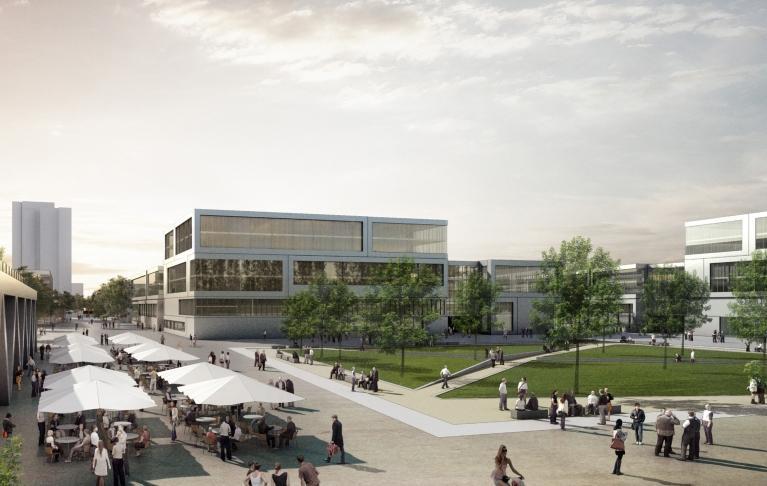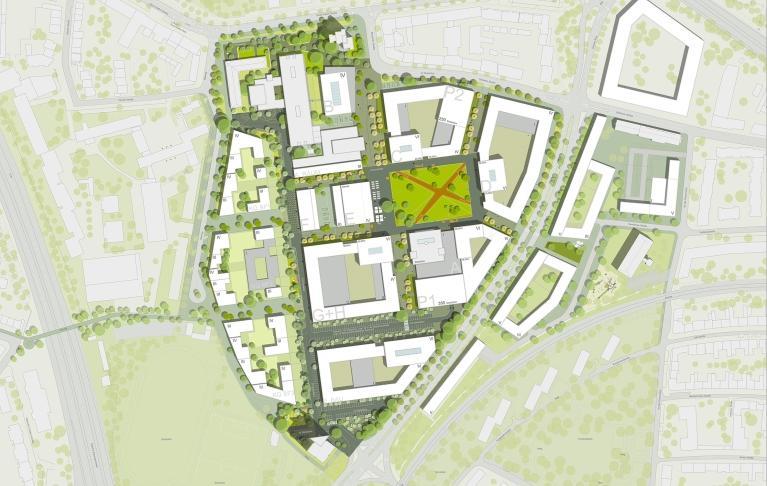New replacement building on the campus of TH Köln, Deutz
Innovative energy concept and sustainable modernisation for a climate-neutral university infrastructure
The Cologne University of Applied Sciences (TH Köln) is currently realising one of the largest university construction projects in North Rhine-Westphalia: The replacement construction of up to eight new buildings is planned at the Deutz campus in order to modernise the ageing building stock and make it fit for the future. With around 10,000 students, the site is the university's largest. The complex challenge is to realise the demolition and new construction by the planned completion date of 2043 while the university continues to operate.
A comprehensive masterplan including an energy concept was already available at the start of the project. The original design envisaged a central campus energy centre that would provide both heating and cooling using combined heat and power plants, absorption chillers and other conventional technologies.
Innovative turnaround in the campus energy project towards a sustainable climate strategy
However, together with the Bau- und Liegenschaftsbetrieb NRW (BLB NRW) and at the suggestion of the Innovation branch of ZWP Ingenieur-AG, the predecessor of MorgenGrün, the system temperatures (70/50 °C in the heating network, 6/12 °C in the cooling network) were scrutinised. The aim was to put the campus supply on a sustainable basis in terms of climate policy in the long term.
Setting the course for a climate-neutral future
In light of the German government's ambitious climate targets and the need to replace fossil fuels, ZWP Niederlassung Innovation (now MorgenGrün) has developed a revised, forward-looking energy concept. This is based on a geothermal system with well water utilisation. The groundwater serves as a heat source and sink, while a state-of-the-art heat pump and free cooling are utilised. In addition, a combined heat and cooling system is integrated to cover continuous cooling requirements, for example for data centres. The predicted reduction in carbon dioxide is impressive: the alternative concept reduces emissions by around 50% compared to the existing building, which corresponds to around 2,200 tonnes of CO2 per year. This remarkable saving emphasises the innovative power of the approach.
Responding to the challenges
The gas supply crisis in the wake of the war of aggression in Ukraine accelerated the consistent conversion of the energy concept to a completely renewable supply. The climate policy challenges and the ambitious targets of the German government had already led to a pioneering decision in favour of a new energy concept. The abundant groundwater resources at the site will not only be utilised for sustainable energy generation, but also to secure the energy supply in the long term. The decision to switch the grid temperatures to a low-exergy system at an early stage is proving to be strategically forward-looking: it enables the use of future technologies that do not require fossil fuels. This means that the buildings are already designed for climate neutrality by 2050.
Sustainability and innovation in practice
The integration of combined heating and cooling ensures high energy efficiency, as the waste heat from the data centre is also used to generate heat. This not only reduces operating costs, but also increases the energy self-sufficiency of the campus. The concept also focuses on flexibility and scalability in order to be able to optimally integrate future requirements and technological developments.
A model project for the future
The new replacement building for the Deutz campus is an example of the successful combination of engineering skills, climate protection and innovative spirit. By opting for a sustainable energy supply based on renewable energies, the project makes an important contribution to achieving climate targets and shows how a modern university infrastructure can go hand in hand with a sustainable energy supply. The collaboration between the client, architecture and engineering teams demonstrates how innovative solutions are not only ecologically and economically sensible, but also technically feasible.
Images: © Atelier Loidl, Berlin
Overview
Building owner and client
Bau- und Liegenschaftsbetrieb (BLB) NRW, Cologne
Architect
Atelier Loidl, Berlin
Time frame
MorgenGrün: 2018 to 2025
ZWP: 2025 to 2039
Services
MorgenGrün: Energy concept, Planning for sanitary technology, heating technology, refrigeration technology, ventilation technology, electrical engineering, communications technology, building automation, heating and cooling supply systems in outdoor facilities
ZWP: Planning and site supervision for sanitary engineering, heating engineering, refrigeration engineering, ventilation engineering, electrical engineering, communications engineering, building automation, heating and cooling supply systems in outdoor facilities
Site size
134,000 m²
Gross floor area (GFA)
176,365 m²
Saved CO2 emissions
2,200 t CO2/aInnovative energy concept and sustainable modernisation for a climate-neutral university infrastructure

